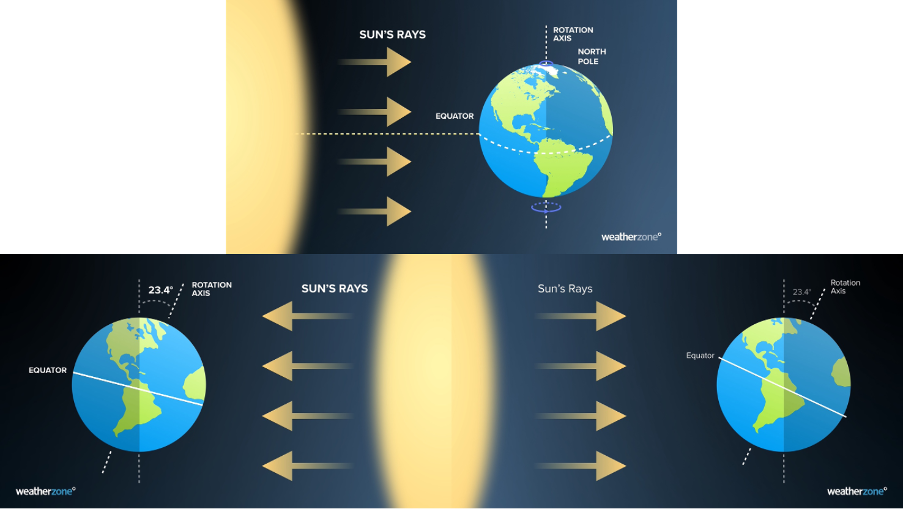The winter conundrum: June 1st, June 21st, or other?
You’ve probably heard that winter is finally here, or less likely, it’s ‘just around the corner’. And you’ve probably felt it too, if you happen to be in the southern or eastern part of the country, like when we saw a QLD town dropping below freezing, cold fronts crossing the country, or thundersnow gracing the alps.
Turns out, nobody really agrees on when the seasons start and end. Here in Australia as well as New Zealand, Pakistan and Russia, people tend to group whole months together and call them seasons, as defined by our 12-month calendar. These are known as the “meteorological seasons” and are based on the annual temperature cycle. In Australia, for example, June, July, and August are the coldest months of the year.
- Winter: June 1st – August 31st
- Spring: September 1st – November 30th
- Summer: December 1st – February 28th/29th (depending on leap-year)
- Autumn: March 1st – May 31st
The Aboriginal people of D’harawal, the nation that encompasses part of the Sydney basin and slightly south, define their own six seasons based on the seasonal adapting of flora and fauna. Interestingly, Aboriginal nations around the country have many different seasonal interpretations, ranging from 2-6 distinct seasons.
 Image: The D'harawal seasons. Source: Bureau of Meteorology.
Image: The D'harawal seasons. Source: Bureau of Meteorology.
In India, the seasons are similar to the meteorological seasons, but monsoon considerations have been inputted.
- Winter: December 1st – February 28th/29th (depending on leap-year)
- Pre-monsoon: March 1st – May 31st
- Monsoon: June 1st – September 30th
- Post-monsoon: October 1st – November 30th
A common method for season determination in China is using average temperature thresholds to define seasons.
- Winter: Period when temperatures are below 10°C on average
- Summer: Period when temperatures are above 22°C on average
Yep, only two seasons. This means that locations with extreme climates, such as Tibet, can have one season year-round, based on this definition.
Similarly, in countries like Sweden and Finland, seasonal changes are a blurry line thanks to their proximity to the north pole. They are defined by the “permanent” exceedance of certain temperature thresholds. In this case, permanent is 5-7 days.
- Winter: Temperature permanently below 0°C
- Spring: Temperature permanently above 0°C
- Summer: Temperature permanently above 10°C
- Autumn: Temperature permanently below 10°C
This means that seasons begin at different times in different parts of the country. Huh?!
A definition that dates back a couple thousand years is the “astronomical seasons” and is the most common seasonal definition currently. The seasons start on the longest day of the year (summer solstice), shortest day of the year (winter solstice), and the days when daylight and darkness are of equal length (equinoxes).
- Winter: June 21st – September 20th
- Spring: September 21st – December 20th
- Summer: December 21st – March 20th
- Autumn: March 21st – June 20th
 Figures: Images representing the equinox (top), winter solstice (left) and summer solstice (right). Source: Weatherzone.
Figures: Images representing the equinox (top), winter solstice (left) and summer solstice (right). Source: Weatherzone.
Like the meteorological seasons, they are grouped into three-monthly periods, though they are offset by about 20 days. They use the exact times that the sun is overhead at the Tropic of Capricorn and Tropic of Cancer latitudes (23.5°N and 23.5°S) as the beginning of summer and winter respectively, meaning that the exact dates fluctuate from year to year, but only slightly (between 2-3 days offset from the 21st of the respective months).
To evolve this further, we can look at the traditional Chinese method of seasonal determination – the “lunisolar seasons”. This definition centralises the start of the seasons around the solstices and equinoxes.
- Winter: 7th November – 3rd February
- Spring: 4th February – 5th May
- Summer: 6th May – 7th August
- Autumn: 8th August – 6th November
It may seem like a random pick of dates, but in the middle of each of these dates are indeed the solstices and equinoxes.
A similar concept is used in the traditional Irish Celtic calendar, which marks the day where the sun is highest in the sky as “midsummer”, as suggested in Shakespeare’s A Midsummer Night’s Dream, set on the summer solstice.
- Winter: 1st November – 31st January
- Spring: 1st February – 30th April
- Summer: 1st May – 31st July
- Autumn: 1st August – 31st October
A certain date should be familiar here – October 31st, or Hallowe’en. Yes, the origins are from the Celts – Hallowe’en marked start of the ‘dark half of the year’ and welcomed the harvest marking the end of the growing period. The darkness was portrayed as the breaking down of the spiritual and physical world, so people would dress up to ward off ghosts.
 Figure: Visualisation of season alignment of various seasonal definitions.
Figure: Visualisation of season alignment of various seasonal definitions.
So, take your pick! So many different definitions of seasons have arisen for as long as humans have been around. The foundation of all these definitions comes down to two things: weather and daylight.
This year’s winter solstice will occur at 12:58 am AEST on Thursday, June 22. From then until the next solstice, days will start to get longer. Read more about the upcoming solstice here.